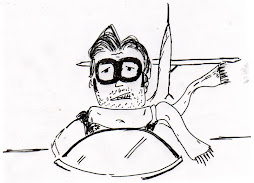 We have young swifts (Apus apus) playing slalom and follow my leader through the telephone wires and the air is filled with shrieks that would do that attractive tennis player Maria Sharpova credit. (By the way the DT recorded her this year at 103.2 decibels at Wimbledon and a rather vulgar thought has crossed my mind!) I digress.
We have young swifts (Apus apus) playing slalom and follow my leader through the telephone wires and the air is filled with shrieks that would do that attractive tennis player Maria Sharpova credit. (By the way the DT recorded her this year at 103.2 decibels at Wimbledon and a rather vulgar thought has crossed my mind!) I digress.The sound I have missed so far this spring and summer is the gentle buzzing of honey bees visiting the garden. For the past 20 years, as the various shrubs and flowers in the Biggles' jungle riotously come into flower in succession from March onwards, the honey bees(Apis mellifera) have followed to grab nectar and pollen. This year, other than the occasional bumble bee, butterfly or solitary bee looking for a hole in the wall to fill with bits of leaf and lay an egg, the honey bees have been noticeably absent. Is it just that my eyesight and hearing are worse than I think, or have other readers noticed the lack of honey bees in their gardens?
The wet June last year was not good for them and I am wondering if the period of heavy rain in late May has had a similar effect this year or is it what the Americans have described as 'colony collapse disorder'?
The US is taking the matter seriously and Congress has held hearings on the problem and has voted $10 million for research. The US estimates that bees are responsible for polinating a third of its crops and that crop value resulting from bee pollination is put at $15 BILLION! A blue-berry farmer from Maine told the Congressional hearing , "Every one of my blue-berries owes its existence to the crazy, neurotic dancing of a honey bee from flower to flower, 'No bees No Crops!"
The implications for our own agricultural industry could be equally serious if honey bees become as rare a sighting as some TDC Planning Committee members on a site visit.


.JPG)










9 comments:
Bertie
I am pleased that you have highlighted this situation as it is something that should concern us all. The following is a link to a web site that I recently came across.
http://www.helpthehoneybees.com/#/home/home/
There is a virus killing them off.
Not just confined to the UK. See: http://www.i-sis.org.uk/MysteryOfDisappearingHoneybees.php
And
It was in Dr Who yesterday lol!
my wife being a keen gardener has also noticed this, I found this article that may shed some light on the subject,,,
Experts ponder bee plague mystery.
A virus that has wiped out billions of honey bees is causing a buzz among scientists.
Experts are mystified by the way the bee plague is transmitted
It had been assumed that deformed wing virus (DWV) replicated inside a parasite which bites bees. But new research shows no evidence of DWV growing within the Varroa destructor mite.
Conventional transmission involving replication within a parasitic carrier which passes the infection on when it feeds therefore cannot apply.
Deformed wing virus has been linked to the collapse of honey bee colonies in the UK. The virus is found in colonies infested with Varroa, which spreads a number of bee infections.
Scientists used an antibody technique to track the viral particles. They discovered that the virus was only found in the mite's gut, suggesting it was merely eaten. It did not appear to invade the mite's cells and reproduce within them.
Chief researcher Professor Teresa Santillan-Galicia from Rothamsted Research institute in Harpenden, Hertfordshire, said: "The presence of deformed wing virus in large amounts in mite faeces suggests it is picked up during feeding on an infected bee. However, one important question remains - how is the virus transmitted to bees?"
Varroa mites cannot regurgitate their gut contents, and so would not be able to transmit the virus this way.
"It is likely that the amount of virus acquired by the mite plays an important role in the interaction between deformed wing virus and the Varroa mite," said Prof Santillan-Galicia.
"Full understanding of the interaction between deformed wing virus and the Varroa mite will provide basic information for the future development of more sustainable control strategies against the mite and the virus... Our work provides elements of understanding but further research in this area is needed
Thanks for that Mike. I have read some US articles that are looking at the increased electro-magnetic environment due to mobile phone masts! Whatever the problem is, its clearly got serious implications.
Even the Daily Mail had a two page article on this very issue a couple of weeks ago. My wife and I felt we should try and take on a beehive in the hope of redressing the balance - but we don't know where to get one from. Any ideas?
We should start a save the Bee campaign
Talk tot he community alotment project on the edge of the millmea estate. They have some hives that seem to be doing well.
One thing to consider when taking on a bee hive is that your nieghbours might have something to say on the subject. I understand that the Community Alotment Project had to move the bees because other alotment holders didn't like it... I did not understand that point of view but it takes all sorts to make the world go round.
Anyway my point is drop by and have a chat. I sure that the Sure Start Children's Centre Partnership Ltd (just up the road from the alotments) might have some contact information and opening times if you give them a call...
Buggered off out of Thanet like any other sane creatures no doubt!
Post a Comment